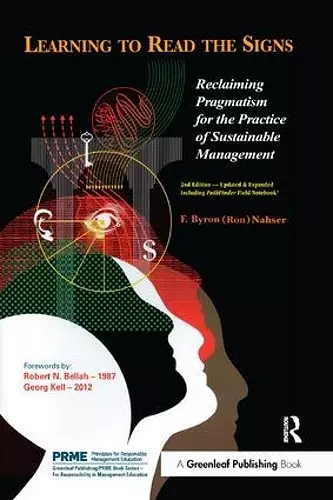Learning to Read the Signs
Reclaiming Pragmatism for the Practice of Sustainable Management
Format:Paperback
Publisher:Taylor & Francis Ltd
Published:31st Aug '13
Currently unavailable, and unfortunately no date known when it will be back
This paperback is available in another edition too:
- Hardback£115.00(9781907643903)

The challenges confronting executives in the 21st century include business complexity, environmental uncertainty, turbulent change processes, and unimaginable quantities of data presented in every imaginable technological form. The truth can be very elusive in the modern world. To make sense of it, leaders need a sharp mind, discerning judgment, and a reliable thought process for analyzing, assessing, and shaping one's options. Ron Nahser brings experience, knowledge, and wisdom to this challenge in his new book, Learning to Read the Signs. As a successful businessman and as a student of business, society, history, and philosophy, Nahser has grappled with the numerous puzzles and traps that challenge the thinking executive. Unlike most of us, however, he has also formalized the thought process that has served him so well, creating what he calls a "path finder" methodology that has been tested and found useful by leaders in a wide variety of organizations. His stated goal is deceptively simple: To learn how to be more "pragmatic" and to continually read what he calls "the signs of the times." This purpose opens the door to a subtle and nuanced understanding of how to "uncover the truth we do not yet know, leading to action we have yet to take." The facts and events that bombard us daily are "signs" that need to be interpreted as they relate to what we already know. To be effective interpreters we need a process to help separate insight from opinion, truth from fallacy. Pragmatism, a philosophical school with deep American roots, provides the answer by showing us how to build a narrative of what is happening by using our detective skills in an iterative process of listening, questioning, and learning. Far from the common "do whatever works" thinking often attributed to the pragmatic thinker, Nahser shows us how to become true pragmatists - path finders - devising our own process of inquiry. The truth, we may discover, lies less in the answer and more in the journey by which we arrive at that answer. -- James E. Post, JD, PhD, The John F. Smith, Jr. Professor of Management, Boston University ... if only all business executives were to read and comprehend Learning to Read the Signs, the world would be a dramatically better place, and corporations would be far more resilient and better prepared to manage present and future challenges. -- Georg Kell, Executive Director, UN Global Compact
In this new edition of his seminal text, Nahser reclaims the profound philosophy of pragmatism and considers how it can be applied to the business world. He outlines a mode of inquiry that can be used to solve cognitive as well as ethical questions, to result in corporate success and a better world.
The PathFinder Lab Journal Field Notebook (Appendix III) is available here.
It's not what we know, but how we learn. This is the key that Learning to Read the Signs uses in order to evaluate and apply ideas and facts to one's organization life. The book asks the reader to go back to and reclaim pragmatism: an activity of thought involving four parts: Investigation, Hypothesis, Action, and Testing. Pragmatism is a method of interpretation or inquiry which offers to the thoughtful business practitioner a way to better understand the reality in which we operate, to think critically and creatively, and for business people to think together to make the best use of all our perspectives and talents. Questions raised in this book include: What are the signs telling us? Where are we headed and why? Why are things going the way they are? What is our purpose?
Examples abound of companies and organizations that have failed to "read the signs": the automobile and the financial services industries are obvious examples. Doing business successfully in the 21st century means becoming aware of the filters that modify and limit business vision in our culture. Without this awareness, many businesses will continue to fall into short-term reactive thinking. In a world facing unprecedented social, environmental, and economic challenges, learning to read the signs is a business imperative. This is not a how-to book in the sense that it provides ten easy answers to everyday business problems. The help it gives is much more profound. This book outlines a mode of inquiry that can be used to solve cognitive as well as ethical questions. Drawing on the deepest resources of philosophical pragmatism, Nahser shows us that often we do not even know the right question to ask, that we must start by trusting our doubts and seeing where they lead, so that we can even begin to ask the right questions. He brings philosophy down to earth by...
This idea of pragmatism goes far beyond the conventional uses of today, but is a historically enduring principle that harnesses the deep intuition of our own perceptions and experiences and integrates it with the rapidly changing currents that surround us. Ron Nahser's remarkable effort to resurrect this profound philosophy in the business world is a bold and noble move and, when applied effectively, will bring forth better, more significant decisions that will enhance both our physical and our spiritual well-being". Dr. Stephen R. Covey - if only all business executives were to read and comprehend 'Learning to Read the Signs', the world would be a dramatically a better place, and corporations would be far more resilient and better prepared to manage present and future challenges. Georg Kell - Executive Director, UN Global Compact Secretariat
ISBN: 9781906093792
Dimensions: unknown
Weight: 490g
240 pages
2nd edition